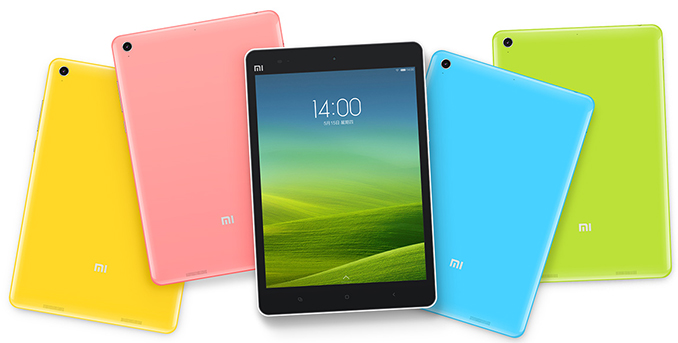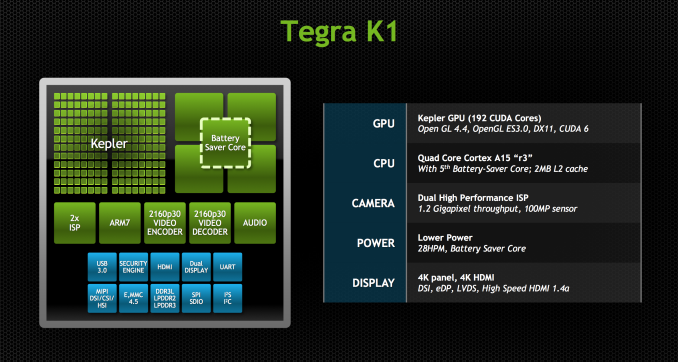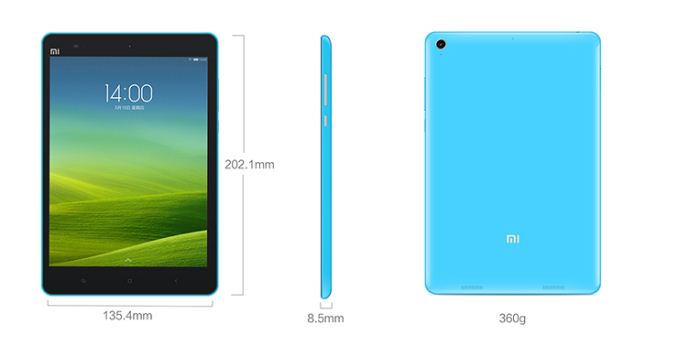Xiaomi Announces the MiPad: The First Tegra K1 Device
by Brandon Chester on May 15, 2014 9:40 AM EST
Today Xiaomi introduced its first tablet: the MiPad. The tablet bears similarity to both Apple’s iPad Mini and iPhone 5c. On the front of the tablet we have a 7.9” 2048x1536 IPS display (sourced from both Sharp and AUO Optronics) which is surrounded by an asymmetrical bezel. On the back we have a plastic shell of multiple different colors which Xiaomi itself states is made with the same injection molding technology as the iPhone 5c. There is also an 8MP Sony camera on the back with an F/2.0 aperture, and a 5MP camera on the front. The most interesting part of the Mi Pad is not on the outside, it's on the inside. The MiPad is the first consumer device to be announced that is powered by NVIDIA's Tegra K1 SoC.
As you may recall, NVIDIA introduced Tegra K1 to the world at CES 2014. It marks a huge departure from NVIDIA's mobile graphics strategy, abandoning the old Tegra GPU roadmap in favor of its desktop Kepler architecture.
Tegra K1 has two flavors, both built on a 28nm HPm process. One uses NVIDIA's Project Denver which will include two custom ARMv8 cores designed by NVIDIA. Denver is not slated to ship until later this year and so what we see in the MiPad is the other flavor of Tegra K1 which is a quad core ARM Cortex A15 design. Similar to other recent Tegra SoCs, this version of the K1 features four Cortex A15s plus an additional companion Cortex A15 optimized for lower frequencies for periods of low CPU usage. The CPU cores are based on a newer revision of Cortex A15 (r3p3) which includes finer grain power gating to reduce power consumption compared to revision r2p1 in the Tegra 4. This increase in efficiency will help balance out NVIDIA's move from a 1.9GHz max clock speed on Tegra 4 to over 2GHz on Tegra K1 (the move to 28nm HPm should help as well). The Tegra K1 SoC in the MiPad will ship with a max clock speed of 2.2GHz and 2GB of LPDDR3 RAM.
The GPU on Tegra K1 is something completely different from previous Tegra designs. Previous Tegra chips integrated NVIDIA's GeForce ULP core designed exclusively for its mobile platforms. With Tegra K1 Nvidia abandoned the idea of having a separate mobile roadmap for GPU designs and has merged its mobile and PC GPU roadmaps. The result is that Tegra K1 and all subsequent designs will ship with GPUs using the same architecture as NVIDIA's PC parts. With Tegra K1 we get a complete implementation of NVIDIA's Kepler architecture with 192 CUDA cores, 4 ROPs, and 8 texture units. It also brings along OpenGL ES 3.0, OpenGL 4.4, DirectX 11, CUDA 6.0, and every other API that Kepler supports.
NVIDIA has also shown a commitment to releasing software that will take advantage of their mobile GPUs. The company recently worked with Valve to bring Half Life 2 and Portal over to the NVIDIA Shield which is powered by a Tegra 4 CPU and I am sure that crafty users will bring the apps over to Tegra K1 devices if NVIDIA does not do so itself.
Beyond the SoC, the other internal specs for the MiPad include a 25.46 Whr (6700mAh) battery, 16 or 64GB of internal NAND, and a MicroSD slot. Connectivity includes support for 802.11 b/g/n/ac and Bluetooth 4.0. As with other Xiaomi devices, the MiPad runs Android with the MIUI UI atop it. It will launch in China sometime in June priced at 1499 yuan ($240) for the 16GB model and 1699 yuan ($272) for the 64GB model.












82 Comments
View All Comments
GC2:CS - Monday, May 19, 2014 - link
None of these really stresses out the SoC and I would like them to give me a solid battery run time, which will be hard to pass whatever I do.ams23 - Thursday, May 15, 2014 - link
You aren't making any sense. Xiaomi clearly had a slide describing battery life of MiPad (80 hours music listening, 17 hours movie watching, and 11 hours of web browsing): http://www.engadget.com/gallery/xiaomi-tablet-laun...And no, Tegra K1 is obviously not a power hungry beast. The GPU is at least 1.5x more power efficient than the A7 GPU. The app processor + mem power consumption on a mobile optimized platform should be no more than ~ 5w with very compute heavy workloads that push all CUDA cores. Remember that this is > 300 GFLOPS GPU throughput, which is unheard of so far in the ultra mobile space!
grahaman27 - Thursday, May 15, 2014 - link
nice catch! And thanks for the translation.Anders CT - Thursday, May 15, 2014 - link
I don't think the K1 is a powerhog exactly. Mine will draw roughly 6 watts after power conversion, factory clocked at 2.3 GHz with all four cores running and the GPU saturated with compute (doing around 350 gflops. The GPU appears to run at 900 MHz, but I could be wrong). Thas pretty decent I think, and clocked more moderately it should easily come down below 2 watts while still performing very well. Unfortunately its not straigh forward to reduce voltage on the jetson board.GC2:CS - Monday, May 19, 2014 - link
6W ? That's more than enough to consider that a power hog.Anders CT - Monday, May 19, 2014 - link
@ GC2:CSI don't think so. Most mobile SoC's will use 6-8 watts when clocked and volted to its design limits and throttling is disabled. The Tegra 3 and Snapdragon S4 boards i have worked with has been more power-hungry than the Jetson TK1.
supgk - Thursday, May 15, 2014 - link
You're all taking a benchmark from a Chinese company of little reputation way too seriously. Especially with NVIDIA in the mix...Let's see how it fares up in real world testing.
deppman - Thursday, May 15, 2014 - link
I have spent weeks with the Jetson TK1 board, and have analyzed the power fairly extensively. I can confirm Nvidia's power claims are accurate to conservative. And my estimates for this tablet, made prior to knowing of the slide, were almost spot-on.===========
I recently spent some quality time with a multimeter and did all sorts of power assessments on the Jetson TK1. The "shocking" number of watts I calculated for SOC + RAM:
1. Idle: 0.6W
2. Web browsing, office apps: 2.19W
3. Demanding gaming (xonotic): 4.74W.
This tablet has a 6700 mAh battery. That's close enough to the 6500 mAh of my earlier analysis provided below.
A 6500 mAh battery is enough juice for 36.2 hours of web browsing, or 16.6 hours of gaming *for the SOC + RAM alone*.
Now of course a tablet requires a screen and other bits like storage. Figure with a high res screen like that and sound we might see about 3W system overhead. So these estimates then look like:
Web browsing: 15hr
Gaming: 10.2hr
If the screen draws another watt or so, we might see 75% of those numbers:
Web browsing: 11.3hr
Gaming: 7.5hr
I expect those last numbers are a reasonable estimate for this tablet.
===========
grahaman27 - Thursday, May 15, 2014 - link
very interesting numbers. did you take into account the clockspeed differences? I would see what the tk1 pulls at 2.2Ghz, which looks like its what nvidia was shooting for in tablets.deppman - Thursday, May 15, 2014 - link
I did not take into account frequency scaling or the difference in clock rates. However, in this case, there was only 0.1 gigahertz difference. the analysis was originally done for the mocha tablet.